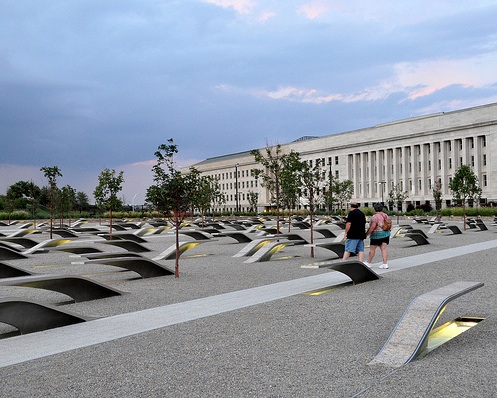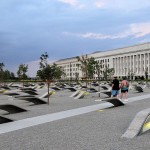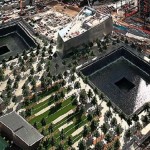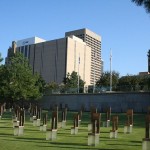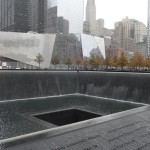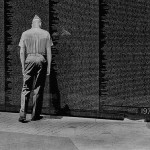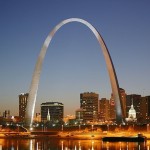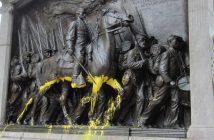On September 11, 2011, a decade after the site was decimated by terror, the foundations of The World Trade Center were reborn as a pair of reflecting pools dedicated to the memory of the countless lives lost. The direct reference to what was destroyed, two structures and the numerous workers within, is striking and poignant. There is no attempt to glaze over exactly what happened on that bright fall day in 2001. The focus of this most recent of our national memorials is the absence of two colossal towers and the individuals who, in death, were linked to the site forever. The memorial pools at Ground Zero serve dual purposes that are equally essential. The first is the fulfillment of their duty to the American public who watched these events unfold. That is, to coalesce in physical form the collective memory of a horrible act. In this way, they become a necessary place marker in the story of our nation and testify to a moment in American history that was a turning point in so many ways. The second task of the memorial is just as important, but rarely as prominent in the public eye. This sometimes overlooked facet of the site’s purpose is that it must also act as the graveside for the numerous families who lost loved ones without any real closure.
The September 11th Memorial, though recently completed, reflects a trend throughout the modern history of memorial design. The notion that memorials should be, at their core, about providing a space to remember has grown throughout the twentieth century. The concept that memorials should be responsive to the needs of the visitor by being open ended has been worked out successfully in several recent memorials, but the concept of the void is one linked to the roots of modernism. Painters like abstract expressionist Mark Rothko drew on eastern themes of simplicity and apparent "emptiness" in their two-dimensional works. This idea translated to further simplicity in other areas, including architecture and memorials. Strangely, the first great modern American "memorial" is not dedicated to loss, but to the triumph and success of an American journey. The St. Louis Arch was born of the wholesale demolition of the city’s waterfront. A product of the common urban renewal practices of the mid century; The Arch trades on traditional symbols of triumph in a sleek, and at the time, novel way. The Arch serves as both a portal for the victorious, a door for new travelers to The West, and as a frame for the city behind it. While the geometry of the shape is powerful, the true weight of the memorial comes from its defining openness, a reminder of the open door to Manifest Destiny. The silver parabola of The Arch, designed by Eero Saarinen, is quintessentially American, to the point that it is a sort of a kitsch Americana version of the classical triumphal arch. Glimmering, brash, and most of all big, the design celebrates the history of American conquest of a continent. The concept of the void materializes here in the negative space that fills the center of the arch. This portal is equal parts architectural and sculptural, and is a forbear of many other memorials of note. It would be followed by memorials that embrace openness as a means of healing as much as of entry. The need for healing in America was particularly great after the Vietnam War. In the upheaval of the sixties and seventies, the response to the war was memorably bad. Young soldiers returning home were greeted by anger and resentment. The many sacrifices made in the unpopular conflict were painful to think about and the notion that they should be remembered or celebrated was challenging. After several years of advocacy on the part of veterans, land was finally set aside for a memorial in 1980. Maya Lin’s design, chosen by a blind jury when the artist was still a student at Yale, proved controversial. Many veterans were displeased by Lin’s unflinchingly blunt interpretation of the disasters of war. The memorial she envisioned amounted to a black scar on the face of the National Mall. The reflective black marble wall, constructed in a "v" formation, descends into the earth and rises again. On its surface the names of the dead are etched, forming a tally of ruin.
The void in the case of the Vietnam Memorial is illustrated both in the absence of ornament and in any above grade structure. It has an incised quality, appearing as though ground has been removed to carve this place into the earth. Lin utilized a modern, even minimalist vocabulary to tabulate the cost of war for viewers and to present the loss as a physical blemish on the country’s doorstep. Instead of celebrating the glory of victory, she names each American victim of the violence and allows their names, rather than images of victory or of the veterans themselves, to do the talking. The focus on absence in memorials can variously be a point of departure and a place for remembrance. At Ground Zero, the twin voids of the memorial pools remind viewers of the once extant towers. The perceived emptiness of the Vietnam memorial is designed to evoke feelings of loss on behalf of a grateful nation. In Oklahoma City, the memorial erected to honor the victims of the 1995 car bombing at the Murrah Federal Building utilizes a direct and individual sense of vacancy to call attention to specific loss of life. The Oklahoma City National Memorial complex, which includes a reflecting pool, memorial gateway, and fragments of the original building, also plays host to the Field of Empty Chairs, an installation of 168 sculptural chairs, each named in memory of a victim. The seats give viewers a palpable understanding of loss, while also allowing visitors with a personal attachment a place for individual reflection. The seats literally map loss. They are arranged to indicate where in the destroyed building the victim worked. These chairs in an open field, now so peaceful after a single moment of hellish destruction, also point to a certain strangeness that overcomes all large-scale memorials. While the bucolic setting seems to heal the wounded ground, it also becomes disquieting. Row upon row of empty seats, like the names on Lin’s wall, calculate loss and bring it closer to the viewer. The empty seat motif is repeated at the September 11th Memorial’s sister monument at the Pentagon. Benches marked with the name of each individual killed in the terror attack on Washington D.C. sit empty over miniature reflecting pools. Like Lin’s Vietnam Memorial, the arrangement here works deftly to individualize loss. Like Oklahoma City’s monument, it materializes that loss in the form of a resting (sitting) place for the victims. It calls each victim by name and gives each family, many of whom were unable to give their loved ones a traditional burial, a place to mourn. Also reminiscent of the Field of Empty Chairs, is the use of space as map. The orientation of the benches, facing toward or away from the crash site, indicates whether the victim was in the building, or a passenger on American Airlines Flight 77. The memorials at the Pentagon and Oklahoma City use voided objects to present individual human stories. Seats without sitters are a powerful symbol of loss, but also provide practical space for visitors to be with their loved ones in a profound way. At Ground Zero, because of the larger scale of the destruction in New York, the memorial is not able to provide the same individual accommodation. The dual pools, the voids of two great structures that once defined the tip of Manhattan, become a shrine and a positioning system. To anyone who knew the site before 9-11, the pools will act as a landmark, which can be used to remember the site that was destroyed and moreover, the human toll of terror. At Ground Zero, and in all of these sites, the central motif of memory is expressed chillingly by marked absences. The use of the void in memorials to war and destruction is a reminder of how memorials function: They allow us to remember the things we have lost and act as landmarks in lives, countries, and sites affected by violence and loss. The perceived emptiness is not completely desolate though. As with abstract expressionist paintings a half-century before, the voids presented at the World Trade Center are not merely vacant spaces, but are depictions in themselves. In this case, the linkage to a particular event makes their expression direct. Their voids will tell visitors for generations that the site was hallowed by destruction and is dedicated to memorializing those lost forever.
- The memorial honoring the victims of the 9/11 terrorist attack on the Pentagon. (Photo Credit: Kevin Harb-from Flickr)
- Photo of the 9/11 memorial taken from the World Financial Center, as it appeared in June 2012.
- Views in and around the Oklahoma City National Memorial. Field of Empty Chairs
- This is a view of one of the fountains located within the site of the World Trade Center, which was destroyed on September 11, 2001. The two fountains, one for each fallen tower, are titled Reflecting Absence and were designed by architect Michael Arad and landscape architect Peter Walker
- A Marine at Vietnam Memorial on 4th July 2002
- St. Louis on the Mississippi river by night. Jefferson National Expansion Memorial aka. Gateway Arch and Old Courthouse are visible.

